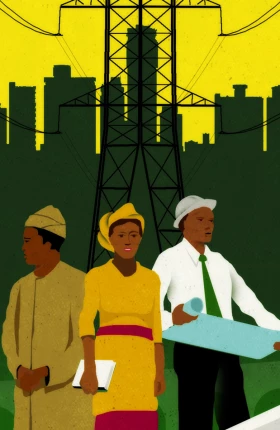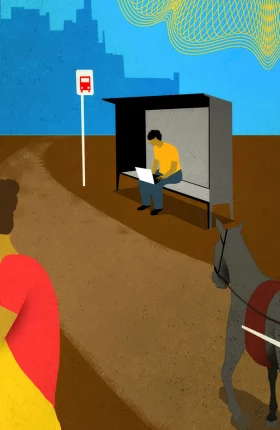Infrastructure investments have a powerful multiplier effect. They enhance accessibility and facilitate trade, improve mobility, generate greater employment opportunities, and boost overall economic productivity. It is hardly surprising that BCG’s Sustainable Economic Development Assessment (SEDA), a diagnostic tool that tracks the relative well-being of countries around the world, has confirmed the broad impact of infrastructure. Recent SEDA findings reveal that, among nations with low well-being, those that make the most progress tend to outperform in infrastructure improvements.
But what distinguishes countries that make great strides in infrastructure from those that do not? Using SEDA as a guide, we set out to answer this question. We took a close look at two countries—India and Indonesia—that have made significant improvements in their infrastructure and, through that, the overall well-being of their citizens.
Examining the strategies and results in both countries, we find that the governments embraced four critical best practices: designing a clear and ambitious program, deploying a systematic and holistic approach (including a focus on strengthening institutions and improving planning), innovating to increase private-sector investment, and embracing rigor in execution and program management. Countries around the world would do well to study and learn from the success of both nations. Although the examples we outline below focus largely on efforts to improve roads in these countries, the best practices have applicability in all areas of infrastructure development including power, information and communications networks, and sanitation.
The Far Reach of Infrastructure
SEDA provides a powerful lens to explore country performance in—and the impact of—infrastructure. This assessment combines objective, factual data on outcomes, such as in health and education, with quasi-objective data, such as governance assessments. It is a relative measure, assessing how countries perform compared with the rest of the world or with individual peers or groups of countries. (See “The SEDA Lens.”)
The SEDA Lens
The SEDA Lens
The current SEDA database covers 143 countries, which account for 97% of the world’s population and 98% of the global economy. SEDA defines well-being on the basis of ten dimensions: income, economic stability, employment, health, education, infrastructure, equality, civil society, governance, and environment. Using indicators from publicly available sources, we can measure company performance in two ways: (1) We aggregate the scores for the ten dimensions to provide an overall SEDA score for each country on a scale of 0 to 100. (2) We compare a country’s SEDA score with the score that would be expected given the country’s gross national income (GNI) per capita through a measure we call the wealth-to-well-being coefficient. Countries that have a coefficient greater than 1.0 deliver higher levels of well-being than would be expected given their GNI levels, while those with a coefficient below 1.0 deliver lower levels of well-being than would be expected.
Although all ten dimensions that make up SEDA are contributors to well-being, it turns out that different dimensions may be more critical depending on a country’s starting point. Recently, we conducted an analysis that broke our data set into two categories: countries with a high well-being level at the start of the period (2009) and those with a low level of well-being in 2009. In the low category, countries that made the largest gains in relative well-being from 2009 through 2018 tended to outperform in infrastructure in particular, as well as in education and governance. In addition, we found that countries in this group that made strong gains in the infrastructure dimension improved not only their overall SEDA scores but also their ability to convert wealth into well-being.
Consider India and Indonesia. Since 2008, Indonesia’s SEDA infrastructure score jumped from 39 to 66, boosting its infrastructure ranking from 102 to 69. That helped power a gain in its wealth-to-well-being coefficient from 1.06 to 1.16. During the same period, India’s SEDA infrastructure score improved from 38 to 53, helping the country to climb from 104 in the SEDA infrastructure ranking to 96 and its wealth-to-well-being coefficient to rise from 0.90 to 1.02. (See Exhibit 1.)
Infrastructure Challenges
The gains in India and Indonesia are even more impressive when we consider the magnitude of the challenge both countries have faced in infrastructure.
Roadblocks hinder progress in India. Whether it is the highway system linking major cities or the roads connecting small towns and villages to those highways, India’s infrastructure was significantly lacking.
But while the government recognized the issue, the rate of road construction was historically slow, with projects taking an average of three to five years to complete. The rate of development was affected by organizational capacity constraints and complexity at the National Highways Authority of India (NHAI), an agency within the Ministry of Road Transport and Highways. Those challenges were evident in the long preparation and appraisal time required for projects and in the absence of an effective project-monitoring system. As a result, the development of highways was running at a sluggish rate of 12 kilometers per day in fiscal-year 2015.
Compounding those challenges was a decline in private-sector funding for infrastructure. While private-sector funding was clearly needed to speed up road construction—roughly enough to fund more than 30% of planned investment—public-private partnerships (PPPs) in India’s highways sector had been declining since fiscal-year 2013. That decline was the result of unbalanced risk sharing between the public and private sectors under the existing model, as well as the perception of high execution risk, which was reflected in several stalled or delayed projects. Many projects that were awarded did not take off or stalled because of issues with land acquisition or other regulatory hurdles such as environmental clearances. As a result, the NHAI started to see diminished interest in new projects that the authority brought to the private market.
Demand outstrips supply in Indonesia. Indonesia’s unique geography and size as an island nation—it is the world’s 15th-largest country by land area and the 4th-most-populous—create extensive and complex road connectivity needs. But the country’s infrastructure has not kept pace with those needs.
According to the World Economic Forum, Indonesia ranked 86 out of 134 nations in 2008 in terms of infrastructure. Kilometers of new road constructed, for example, were running at 3% annually from 2000 through 2017 while the number of vehicles on the road increased at a 12% clip during that period. And in the capital city of Jakarta, home to over 10 million people, the combination of substandard roads, congestion, and the lack of adequate public transportation makes travel exceedingly difficult. The average rush-hour speed is 10 kilometers per hour, and commuters spend about 63 hours every year in traffic jams, making Jakarta the world’s 12th-worst city in terms of traffic according to the 2017 INRIX Traffic Scorecard.
Four Best Practices in Infrastructure
Given the critical role of infrastructure in both economic and well-being progress, India and Indonesia needed to find a winning formula to address their significant infrastructure challenges. To accelerate progress, both countries developed strategies tailored to their unique set of budget and societal realities. But a close study of efforts in the two countries reveals a focus on four best practices.
Designing a Clear and Ambitious Program. Governments need to put their energy and resources behind large-scale infrastructure projects if they are to succeed.
In India, phase I of the Bharatmala Project aimed to spend about $100 billion from October 2017 through December 2022 to develop 34,800 kilometers of national highway (bringing the total network to 84,000 kilometers) and to enhance the infrastructure of several key economic corridors and improve the connectivity of the country’s ports.
For its part, the Indonesian government has been focusing on infrastructure in the past decade: infrastructure spending has increased from 9.5% of the 2014 budget allocation
Deploying a Systematic and Holistic Approach. Commitment is important—but it will have little impact absent a system that is primed for driving infrastructure development.
In India, this included a revamping of the NHAI. The structure of the department was reorganized, and performance management was improved with clear KPIs. In addition, responsibilities were streamlined across the hierarchy, and new training was instituted to build critical capabilities. At the same time, the NHAI adopted value engineering, which allowed for the standardization of certain project elements. For example, the construction of roads that pass over a rail line is common on many large projects, so the NHAI developed a standard design for such elements. By embracing standardization, the department was able to cut preparation time and reduce the construction timetable and expense.
In Indonesia, the government took steps to improve the efficiency and speed of the infrastructure development process. The government established the Committee for Acceleration of Priority Infrastructure Delivery in 2014 to improve agency coordination related to a series of strategically important, high-priority projects.
At the same time, Indonesia took aim at barriers to infrastructure development, particularly those related to land acquisition. Recently revised regulations allow the government to revoke land rights on the basis of public interest and enable businesses to acquire land at market prices on behalf of the authorities and be reimbursed later. Such regulations helped accelerate land acquisition for the long-delayed trans-Sumatra toll road project and the Java North Line double-track rail projects. In addition, the government issued a special policy to accelerate land procurement along the first corridor of the Jakarta Mass Rapid Transit (MRT), the city’s long-delayed underground train system.
Indonesia also moved to improve critical skills and capabilities. For example, employees who were going to operate the Jakarta MRT received training not only at home but also in Malaysia. Managers and division heads, meanwhile, received training in Japan and Hong Kong, respectively. The goal: to ensure that the MRT was run in line with international standards.
Innovating to Increase Private-Sector Participation. Tapping the resources and expertise of the private sector can accelerate infrastructure progress.
India in particular has made great strides in the development of new strategies to attract more private participation in infrastructure development, including drawing on private-sector expertise in project execution.
After years of declines in PPP activity, the Indian government realized that it needed new contracting models. The objective was to create arrangements that were a middle ground between 100% government funding and 100% private funding—frequently a PPP structure known as build-operate-transfer (BOT). The government addressed that gap by adopting two new models:
- The Hybrid Annuity Model (HAM). The government contributes up to 40% of the project cost, while the private-sector developer contributes the remainder, funded through a mix of debt and equity. The ownership of the asset and the right to collect the toll remain with the NHAI, while the private developer receives a guaranteed annuity.
- The Toll-Operate-Transfer (TOT) Model. The private company pays an upfront fee, handles all the operations and maintenance spending for an existing roadway, and collects and retains all the road’s tolls for a period of 30 years or so. Projects under this model are awarded as a bundle, allowing the investor to offset the risks of one project against another.
The new models are already paying off, with the share of PPP projects in the highways sector increasing from 20% in 2016 to 45% in 2017. The government has used the HAM for over 60 projects worth more than $10 billion. In addition, the first package of nine highways totaling about 680 kilometers has been monetized under the TOT model, bringing in $1.45 billion for the government. And other ministries in India are beginning to adopt the new models in order to attract private-sector capital to some of their own projects.
Indonesia has also made progress in improving the environment for PPPs. The government created a PPP Joint Office in 2017, bringing together representatives from seven ministries and agencies to improve coordination of PPP efforts. The government created a standard format to assess feasibility and develop business case studies for new projects. It also provides support, including funding, for review and revision or other project preparation. The government created the Indonesia Infrastructure Guarantee Fund to improve the creditworthiness and quality of PPPs. And easing of foreign-investment restrictions has helped to promote infrastructure investment.
Embracing Rigor in Execution and Program Management. Ambitious infrastructure investment plans require effective program management.
India has invested in this capability, developing the state-of-the-art Project Monitoring Information System (PMIS). The PMIS is a comprehensive database with more than 180 data fields tracked for each project, such as the progress being made in design, contracting, construction, and land acquisition, as well as compensation disbursement, tolls, and traffic. An additional 500 metrics are tracked specifically for complex PPP projects. All that information is accessible to NHAI management through a single dashboard, creating effective fact-based accountability.
The PMIS also provides a geographical visualization of all NHAI projects, with 138,000 kilometers of national highways mapped and superimposed on the nation’s entire rail network.
The Impact of a New Strategy
The payoff from the infrastructure drive in India and Indonesia is evident.
In India, the awarding and construction of highway projects grew 29% and 31%, respectively, on a compound annual basis from fiscal-year 2015 through fiscal-year 2018. As a result, the rate of highway construction increased from 12 kilometers per day in 2014–2015 to 27 kilometers per day in 2017–2018. Not only have the infrastructure interventions successfully increased the rate of construction, but they have been instrumental in bringing PPP back to the highways sector. (See Exhibit 2.) This has also led to an improvement in the quality of the overall road network, with SEDA scores for road quality more than doubling from 26.3 to 58.5 from 2008 through 2019.
In Indonesia, meanwhile, some 44% of the country’s roads were rated as “good” in 2017, up from 38% in 2007. (See Exhibit 3.) In addition, the initial phase of the Jakarta MRT project finished in 2019 and is now serving more than 90,000 passengers per day, exceeding its target of 65,000 daily users in the first year. At the same time, the country’s actions to attract private-sector infrastructure players are paying off: Indonesia received the second-highest level of private investment in 2018 (about $6.9 billion) and was ranked by the World Bank as a top-five destination for private participation in infrastructure for three consecutive years.
Gains from the new strategies in India and Indonesia are not limited to transportation infrastructure, as analysis of a number of SEDA indicators makes clear. The percentage of the population with access to improved water sources, for example, grew from 87.4% to 94.1% in India and from 82.6% to 87.4% in Indonesia. In addition, the quality of the electricity supply improved in both countries, climbing from 72.2 to 79.3 on a 100-point scale in India and from 90.20 to 93.5 in Indonesia.
Driving Well-Being Through Infrastructure
SEDA underscores that infrastructure and sustainable development are increasingly linked, particularly in emerging markets. Yet more often than not countries and regions fail to deliver the full potential impact from their infrastructure investments owing to poorly targeted and executed projects.
To address this, governments must marry ambition with effective execution. This requires identifying the obstacles—whether that means overly restrictive regulations or a lack of expertise and skills in certain departments—and tackling those problems head-on. It also demands innovations in how government partners with the private sector and excellence in project management.
We have leveraged SEDA through partnerships with governments around the world to help them adopt these best practices in a way that fits their individual context and challenges. Countries that embrace these best practices will be able to accelerate their progress in infrastructure—with those advances providing a powerful catalyst for improvements in the well-being of their citizens.









